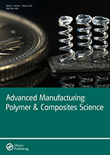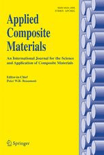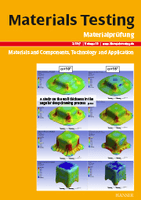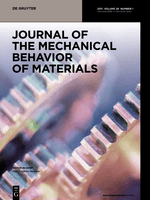
Advanced Manufacturing-Polymer & Composites Science
Scope & Guideline
Unlocking the Potential of Composites in Manufacturing
Introduction
Aims and Scopes
- Advanced Manufacturing Techniques:
Focuses on the development and optimization of novel manufacturing processes such as additive manufacturing, resin transfer molding, and vacuum infusion, specifically for polymer and composite materials. - Material Performance and Properties:
Investigates the mechanical, thermal, and chemical properties of various polymer composites, including bio-based and recycled materials, emphasizing their applications in industries like aerospace, automotive, and biomedical. - Process Optimization and Modeling:
Utilizes advanced optimization techniques, including Bayesian optimization and Taguchi methods, to enhance manufacturing processes and predict outcomes, ensuring improved efficiency and product quality. - Sustainability and Waste Management:
Explores methods for recycling and reusing composite materials, focusing on environmental impact and the development of bio-based composite solutions. - Innovative Testing and Characterization Methods:
Develops new experimental and numerical techniques for evaluating the performance of composite materials, including fatigue testing and in-situ monitoring of curing processes.
Trending and Emerging
- Additive Manufacturing Innovations:
A surge in research on additive manufacturing techniques, particularly for creating complex geometries in biomedical and aerospace applications, signifies a growing interest in this area. - Bio-based and Sustainable Materials:
An increasing number of studies focus on bio-based composites and sustainable manufacturing practices, highlighting a trend towards environmentally friendly materials and processes. - Advanced Process Simulation and Optimization:
The use of sophisticated modeling and simulation techniques to predict and optimize manufacturing outcomes has gained prominence, demonstrating a shift toward data-driven manufacturing approaches. - Recycling and Waste Valorization:
Research on the recycling of composite materials and the valorization of waste materials reflects a growing concern for sustainability and resource efficiency in the manufacturing sector. - Multi-objective Optimization Techniques:
There is a notable trend towards employing multi-objective optimization methods to balance competing manufacturing goals, such as cost, performance, and environmental impact, showcasing a sophisticated approach to process design.
Declining or Waning
- Traditional Composite Manufacturing Processes:
There has been a noticeable reduction in papers focusing on conventional composite manufacturing techniques, such as autoclave molding, as more emphasis is placed on advanced and automated methods. - Basic Material Characterization:
Research centered on fundamental material characterization without the application of advanced techniques or innovative methodologies is less prevalent, indicating a shift towards more applied and practical studies. - Homogeneous Material Systems:
The exploration of homogeneous polymer systems is declining in favor of more complex hybrid and composite materials, reflecting the industry's move towards multifunctional materials.
Similar Journals

APPLIED COMPOSITE MATERIALS
Unlocking Potential through Composite InnovationsAPPLIED COMPOSITE MATERIALS is a leading peer-reviewed journal published by Springer, dedicated to advancing the field of composite materials and their applications. With an ISSN of 0929-189X and E-ISSN of 1573-4897, this journal serves as an essential resource for researchers, professionals, and students interested in the innovative approaches and technological progress within the realm of composite materials. Based in the Netherlands, APPLIED COMPOSITE MATERIALS is recognized in the 2023 Scopus rankings, holding a prestigious Q2 quartile position in the Ceramics and Composites category, further exemplifying its impact with a rank of #59 out of 127 in materials science. The journal has been at the forefront of composite material research since its inception in 1994 and continues to offer open access to high-quality publications that address both theoretical and practical applications in the field. Researchers can count on this journal to disseminate cutting-edge findings and foster collaboration, driving innovation in composite material development.

COMPOSITES PART A-APPLIED SCIENCE AND MANUFACTURING
Elevating Standards in Composite ManufacturingCOMPOSITES PART A-APPLIED SCIENCE AND MANUFACTURING, published by Elsevier Science Ltd, is a premier international journal that serves as a vital platform for the dissemination of high-impact research and innovation in the fields of composite materials and manufacturing technologies. With an impact factor that reflects its outstanding reputation, this journal is categorized in the Q1 quartile for both Ceramics and Composites and Mechanics of Materials, positioning it among the top journals in these disciplines. It holds impressive ranks in Scopus, specifically Rank #16 out of 398 in Engineering - Mechanics of Materials and Rank #10 out of 127 in Materials Science - Ceramics and Composites, reinforcing its authoritative stance in the field. Spanning from 1996 to 2024, the journal features a wide array of research articles, reviews, and case studies that collectively enhance understanding and foster advancements in composite materials. With an open access model facilitating wide dissemination, COMPOSITES PART A is indispensable for researchers, professionals, and students striving to push the boundaries of materials science and engineering.

Materials Testing
Elevating Standards in Material Testing and EngineeringMaterials Testing is a renowned journal published by Walter de Gruyter GmbH, serving the global scientific community in the fields of Materials Science, Mechanical Engineering, and Mechanics of Materials. With an ISSN of 0025-5300 and an E-ISSN of 2195-8572, this journal has been a significant contributor to the discourse on material performance, testing methodologies, and engineering innovations since its inception. The journal is recognized for its rigorous peer-review process and holds a commendable Q2 quartile ranking in multiple categories for 2023, showcasing its impact and relevance in the field. With open access options available, Materials Testing aims to disseminate valuable research findings and practical insights that drive advancements in technology and materials applications. By addressing the latest challenges and developments within the field, this publication serves as an essential resource for researchers, professionals, and students alike, fostering a deeper understanding of material properties and testing techniques.

Elastomers and Composites
Driving Progress in Elastomers and Composite TechnologiesElastomers and Composites is a leading academic journal dedicated to the advancement of knowledge in the fields of polymer science and materials engineering, specifically focusing on elastomers and composite materials. Published by RUBBER SOC KOREA, this journal serves as a vital platform for researchers and professionals to disseminate innovative research findings and insights in material properties, applications, and synthesis techniques. Although it currently does not offer open access, the journal provides rigorous peer-reviewed content that enhances the global dialogue on elastomeric materials and their composites, reflecting its commitment to high-quality scholarship. With a strong emphasis on practical relevance and theoretical advancements, Elastomers and Composites aspires to reshape industry practices and academic thought, making it an invaluable resource for students, researchers, and practitioners alike. Positioned strategically within its field, this journal fosters collaboration and dialogue among scientific communities, all while supporting the growth of cutting-edge research programs worldwide.

JOURNAL OF THE MECHANICAL BEHAVIOR OF MATERIALS
Showcasing Cutting-Edge Research in Materials ScienceJOURNAL OF THE MECHANICAL BEHAVIOR OF MATERIALS, published by DE GRUYTER POLAND SP Z O O, is a prominent open-access journal in the field of materials science and mechanics, dedicated to facilitating the dissemination of high-quality research findings since 2019. With an ISSN of 0334-8938 and an E-ISSN of 2191-0243, this journal provides a platform for researchers, professionals, and students to explore the mechanical behaviors of various materials, crucial for advancing engineering and scientific applications. The journal's impact is evidenced by its impressive rankings, including Q2 status in both Materials Science (miscellaneous) and Mechanics of Materials as of 2023. With a Scopus rank placing it in the top-half of indexed journals, the JOURNAL OF THE MECHANICAL BEHAVIOR OF MATERIALS is a vital resource for anyone looking to stay at the forefront of material behavior research. Based in Germany, it serves the global academic community while catering to the evolving needs of industry practitioners through its comprehensive open-access model.

Journal of Industrial Textiles
Transforming Materials Science through TextilesJournal of Industrial Textiles, published by SAGE Publications Inc, is a leading academic journal that focuses on the intricate interplay between textile materials and industrial applications. With a significant impact factor and a strong reputation in the field, it caters to a diverse audience ranging from researchers and professionals to students interested in the advancement of textile engineering, chemical engineering, and materials science. The journal offers invaluable insights into innovative textile processes, sustainable practices, and the latest technological developments as it spans research contributions from 1971 to the present. Notably, it ranks in the second quartile across various categories, including Chemical Engineering and Industrial and Manufacturing Engineering, reflecting its influence and quality in the scientific community. Although it is not an open access journal, the Journal of Industrial Textiles remains a critical resource for advancing knowledge and fostering collaboration within the textile sector and related fields.

Journal of Polymer & Composites
Connecting Researchers to Shape the Future of Composite Materials.Journal of Polymer & Composites, with ISSN 2321-8525 and E-ISSN 2321-2810, is an esteemed academic journal published by STM JOURNALS, dedicated to the advancement of knowledge in the rapidly evolving fields of polymer science and composite materials. The journal serves as a pivotal platform for researchers and professionals, offering cutting-edge research articles, reviews, and case studies that explore innovative developments and applications in polymer chemistry, material science, and engineering. Although currently lacking an impact factor citation, the journal aims to foster dialogue among academia and industry partners, addressing the latest trends and breakthroughs that drive the field forward. With a commitment to scholarly excellence, the Journal of Polymer & Composites is positioned as an essential resource for enhancing the understanding of polymer composites and their multifaceted applications. Notably, STM JOURNALS' reputation for quality publications underscores the journal’s importance in facilitating impactful research and educational initiatives worldwide.

INTERNATIONAL POLYMER PROCESSING
Fostering Collaboration in Chemical and Materials SciencesINTERNATIONAL POLYMER PROCESSING, published by WALTER DE GRUYTER GMBH, serves as a crucial platform for professionals and researchers in the fields of Chemical Engineering, Industrial and Manufacturing Engineering, and Materials Science, particularly focusing on polymers and plastics. With its ISSN 0930-777X and E-ISSN 2195-8602, this journal has been in circulation since 1988 and continues to expand its contributions to contemporary research trends through to 2024. Ranking in the third quartile across multiple categories, including Chemical Engineering (miscellaneous) and Materials Chemistry, it offers insightful and rigorous peer-reviewed articles that enhance the understanding of polymer processing technologies and innovations. This journal is vital for anyone engaged in polymer science and engineering, providing both theoretical and practical perspectives that advance the field. Although it does not provide open access, the journal's content is indispensable for academia and industry professionals looking to stay at the forefront of polymer research.

JOURNAL OF CERAMIC PROCESSING RESEARCH
Exploring New Horizons in Material ScienceJOURNAL OF CERAMIC PROCESSING RESEARCH, published by the Korean Association for Crystal Growth, Inc., serves as a vital source of scholarly communication in the field of ceramics and composites. With an ISSN of 1229-9162, this well-regarded journal aims to advance knowledge through rigorous research and publication of innovative studies that push the boundaries of ceramic processing technologies. Indexed in Scopus and boasting a 2023 Q3 ranking in the ceramics category, it provides a platform for researchers to disseminate their findings and engage with emerging trends in material science. The journal reflects a commitment to contributing to the scientific community, emphasizing the importance of interdisciplinary collaboration and advancements in fabrication techniques. Although it operates under a traditional access model, the journal is a beacon for researchers, professionals, and students, inviting them to explore breakthroughs from the years 2000 through 2024 and beyond.

JOURNAL OF COMPOSITE MATERIALS
Elevating Standards in Material SciencesJOURNAL OF COMPOSITE MATERIALS, published by SAGE PUBLICATIONS LTD, is a premier academic journal dedicated to advancing the field of composite materials. With a long-standing history since 1967, this journal serves as a vital platform for researchers and professionals in the areas of ceramics and composites, materials chemistry, mechanical engineering, and mechanics of materials. The journal's impact is further underscored by its Q2 quartile ranking in various categories as of 2023, alongside notable Scopus rankings in multiple engineering and material science disciplines. Though it currently lacks Open Access options, its rigorous peer-review process ensures the high quality and relevance of its published research. This journal is instrumental in fostering innovation and promoting collaboration among academics and industry professionals, making it essential reading for anyone involved in materials science and engineering.